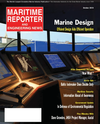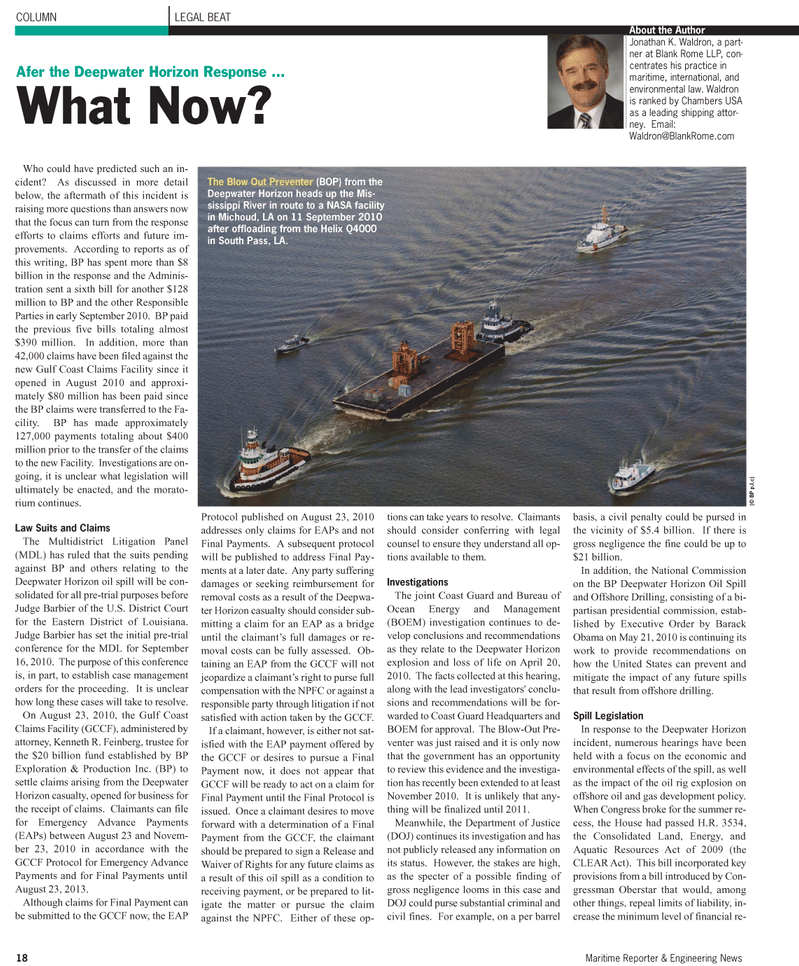
Page 18: of Maritime Reporter Magazine (October 2010)
Marine Design Annual
Read this page in Pdf, Flash or Html5 edition of October 2010 Maritime Reporter Magazine
18 Maritime Reporter & Engineering News
Who could have predicted such an in- cident? As discussed in more detail below, the aftermath of this incident is raising more questions than answers now that the focus can turn from the response efforts to claims efforts and future im- provements. According to reports as of this writing, BP has spent more than $8 billion in the response and the Adminis- tration sent a sixth bill for another $128 million to BP and the other Responsible
Parties in early September 2010. BP paid the previous five bills totaling almost $390 million. In addition, more than 42,000 claims have been filed against the new Gulf Coast Claims Facility since it opened in August 2010 and approxi- mately $80 million has been paid since the BP claims were transferred to the Fa- cility. BP has made approximately 127,000 payments totaling about $400 million prior to the transfer of the claims to the new Facility. Investigations are on- going, it is unclear what legislation will ultimately be enacted, and the morato- rium continues.
Law Suits and Claims
The Multidistrict Litigation Panel (MDL) has ruled that the suits pending against BP and others relating to the
Deepwater Horizon oil spill will be con- solidated for all pre-trial purposes before
Judge Barbier of the U.S. District Court for the Eastern District of Louisiana.
Judge Barbier has set the initial pre-trial conference for the MDL for September 16, 2010. The purpose of this conference is, in part, to establish case management orders for the proceeding. It is unclear how long these cases will take to resolve.
On August 23, 2010, the Gulf Coast
Claims Facility (GCCF), administered by attorney, Kenneth R. Feinberg, trustee for the $20 billion fund established by BP
Exploration & Production Inc. (BP) to settle claims arising from the Deepwater
Horizon casualty, opened for business for the receipt of claims. Claimants can file for Emergency Advance Payments (EAPs) between August 23 and Novem- ber 23, 2010 in accordance with the
GCCF Protocol for Emergency Advance
Payments and for Final Payments until
August 23, 2013.
Although claims for Final Payment can be submitted to the GCCF now, the EAP
Protocol published on August 23, 2010 addresses only claims for EAPs and not
Final Payments. A subsequent protocol will be published to address Final Pay- ments at a later date. Any party suffering damages or seeking reimbursement for removal costs as a result of the Deepwa- ter Horizon casualty should consider sub- mitting a claim for an EAP as a bridge until the claimant’s full damages or re- moval costs can be fully assessed. Ob- taining an EAP from the GCCF will not jeopardize a claimant’s right to purse full compensation with the NPFC or against a responsible party through litigation if not satisfied with action taken by the GCCF.
If a claimant, however, is either not sat- isfied with the EAP payment offered by the GCCF or desires to pursue a Final
Payment now, it does not appear that
GCCF will be ready to act on a claim for
Final Payment until the Final Protocol is issued. Once a claimant desires to move forward with a determination of a Final
Payment from the GCCF, the claimant should be prepared to sign a Release and
Waiver of Rights for any future claims as a result of this oil spill as a condition to receiving payment, or be prepared to lit- igate the matter or pursue the claim against the NPFC. Either of these op- tions can take years to resolve. Claimants should consider conferring with legal counsel to ensure they understand all op- tions available to them.
Investigations
The joint Coast Guard and Bureau of
Ocean Energy and Management (BOEM) investigation continues to de- velop conclusions and recommendations as they relate to the Deepwater Horizon explosion and loss of life on April 20, 2010. The facts collected at this hearing, along with the lead investigators' conclu- sions and recommendations will be for- warded to Coast Guard Headquarters and
BOEM for approval. The Blow-Out Pre- venter was just raised and it is only now that the government has an opportunity to review this evidence and the investiga- tion has recently been extended to at least
November 2010. It is unlikely that any- thing will be finalized until 2011.
Meanwhile, the Department of Justice (DOJ) continues its investigation and has not publicly released any information on its status. However, the stakes are high, as the specter of a possible finding of gross negligence looms in this case and
DOJ could purse substantial criminal and civil fines. For example, on a per barrel basis, a civil penalty could be pursed in the vicinity of $5.4 billion. If there is gross negligence the fine could be up to $21 billion.
In addition, the National Commission on the BP Deepwater Horizon Oil Spill and Offshore Drilling, consisting of a bi- partisan presidential commission, estab- lished by Executive Order by Barack
Obama on May 21, 2010 is continuing its work to provide recommendations on how the United States can prevent and mitigate the impact of any future spills that result from offshore drilling.
Spill Legislation
In response to the Deepwater Horizon incident, numerous hearings have been held with a focus on the economic and environmental effects of the spill, as well as the impact of the oil rig explosion on offshore oil and gas development policy.
When Congress broke for the summer re- cess, the House had passed H.R. 3534, the Consolidated Land, Energy, and
Aquatic Resources Act of 2009 (the
CLEAR Act). This bill incorporated key provisions from a bill introduced by Con- gressman Oberstar that would, among other things, repeal limits of liability, in- crease the minimum level of financial re-
COLUMN LEGAL BEAT
Afer the Deepwater Horizon Response ...
What Now?
About the Author
Jonathan K. Waldron, a part- ner at Blank Rome LLP, con- centrates his practice in maritime, international, and environmental law. Waldron is ranked by Chambers USA as a leading shipping attor- ney. Email:
The Blow Out Preventer (BOP) from the
Deepwater Horizon heads up the Mis- sissippi River in route to a NASA facility in Michoud, LA on 11 September 2010 after offloading from the Helix Q4000 in South Pass, LA. (© BP p.l.c)

 17
17

 19
19
